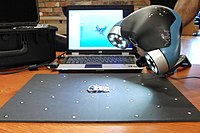
Photo from wikipedia
The purpose of this case report is to present a deviation analysis made to evaluate the accuracy and reproducibility of virtual surgical planning—computer-aided design—computer-aided manufacturing (CAD/CAM) technology. These techniques were… Click to show full abstract
The purpose of this case report is to present a deviation analysis made to evaluate the accuracy and reproducibility of virtual surgical planning—computer-aided design—computer-aided manufacturing (CAD/CAM) technology. These techniques were used to programme and perform both demolitive and reconstructive surgery in an 18-year-old man treated for a mandibular ameloblastoma. Total body CT scan and CT angiography were performed before the surgery. DICOM-format data were captured and a planning was performed using CAD/CAM technology. After the surgery, DICOM files of a postoperative CT scan were evaluated to assess the accuracy of the reconstruction. The deviation of the postoperative result from what was planned was indicated with different colours in a mandible mapper and changes in condylar and angular position between 0.5 mm and 2 mm were observed. A standardised method to evaluate accuracy or efficiency of CAD/CAM technology is still not available, nevertheless, since the patient has a good functional or aesthetic recover, the authors are satisfied with the results.
Journal Title: BMJ Case Reports
Year Published: 2022
Link to full text (if available)
Share on Social Media: Sign Up to like & get
recommendations!